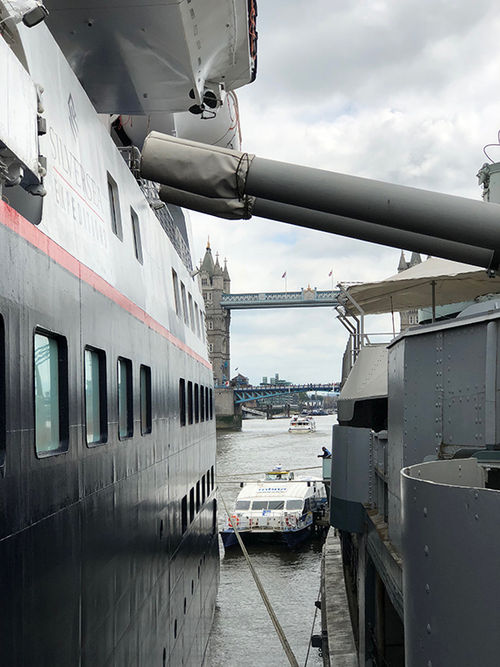LONDON -- For at least 1,000 years, this capital city of Great Britain and the British Empire has been at the heart of world events. Along the banks of the Thames River sit some iconic English landmarks -- the Tower of London, the Houses of Parliament, Westminster Abby and clock tower of Big Ben.
So starting a cruise in the heart of London on a 17,000-ton ship was a chance to see the river and its fabulous history the way few can.
Silversea Cruises had brought its Silver Cloud to the city to celebrate the 10th anniversary of its first expedition-cruise departure. The 296-passenger Silver Cloud, once a part of Silversea's luxury fleet, was converted last year to cruise the polar regions and to do other expedition itineraries. It would host a two-day cruise from Ireland departing from some pilings in the middle of the crowded, muddy Thames.
Getting to the ship was its own adventure. The London berth is a provisional one, since only a few cruise ships these days are small enough to be able to make it that far up river and fit through the opening of the Tower Bridge.
When they do, they tie up at a mooring about 100 feet off the river's south bank, alongside the HMS Belfast, a WWII-era British warship that has served as permanent museum since 1971.

Boarding the Silver Cloud is its own adventure. © TW photo by Tom Stieghorst
Passengers start by boarding an excursion boat at the Millennium Tower Pier on the north side of the river, to be ferried across the channel where they debark on a small platform and climb a gangway onto the deck of the Belfast.
From there, they troop forward across the deck of the light cruiser, hand luggage in tow, to another gangplank that spans the 20-foot gap between the Belfast and the Silver Cloud, providing access to the cruise ship.
The bow of the Silver Cloud was pointed upriver upon boarding, which means that the ship would have to depart aft first. Two tugs helped the Silver Cloud ease away from its berth and through the open bascule of the 128-year-old Tower Bridge.
It was an amazing sight to pass beneath the open jaws of the bridge, with traffic stopped and British pedestrians waving to us from both sides of the span.
The Silver Cloud continued its backwards procession down the river, past Victorian-era quays, wharves and warehouses now converted to trendy apartments, to a turning basin about 30 minutes down river, where we finally swung around to point our bow toward the ocean.
By that time, we were no longer surrounded by sight-seeing boats, water taxis, scows, barges and other marine traffic. We proceeded along the Pool of London river route navigated by thousands of merchant and sailing vessels that made London the maritime capital of the world in the 18th and 19th centuries.
Those ships increasingly tied up in the Docklands, an 8-square mile section of east London marshland that became the largest port in the world in the 19th century. After containerization made it obsolete in the 1960s and 1970s, the Docklands were redeveloped into a high-rise financial center. Silver Cloud passengers got a close look as the ship passed the area.
Another five minutes brought us to Greenwich, the London dockage for cruise ships that are too large to make it further upstream. Even the Silver Cloud must take care to depart at high tide to ensure it has the draft to clear the river bottom.
At Greenwich, the Silver Cloud saluted its sister ship docked there, the Silver Spirit, which had recently been cut in two and stretched to add extra capacity.

The Millennium Dome, downstream from central London. © TW photo by Tom Stieghorst
Further on, a few more landmarks keep the river interesting. About 10 minutes past Greenwich sits the oddly constructed Millennium Dome, an enormous fabric tent suspended by a network of cables from 12 crane-like yellow king posts. Built to commemorate the millennium in 1999, the former exhibition hall is now a concert venue.
Another half-hour brings us to the Thames Barrier, a futuristic looking set of locks and structures opened in 1984 to prevent London from being flooded by high tides and storm surges.
From there, the Thames continues to wind through the green English countryside, widening gradually until it eventually merges with the North Sea passed Tilbury, four or five hours from center city London.

The engineering of the space-age looking Thames Barrier keeps central London from flooding during high tides and storm surge periods. © TW photo by Tom Stieghorst